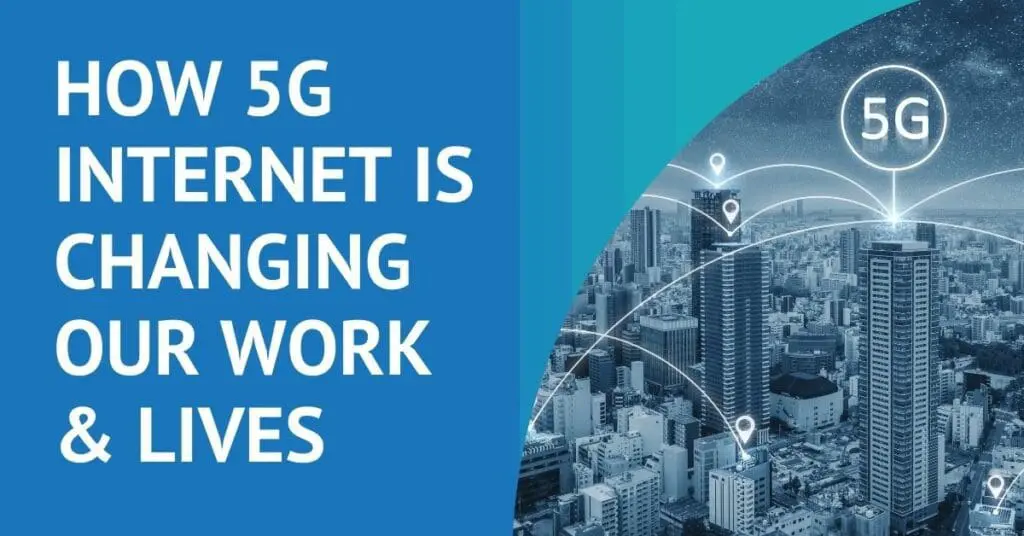How 5G Internet Is Changing the Way We Work and Live

The internet has altered our world in many different ways, and 5G internet is on the path to shake things up again. 5G, short for “fifth generation,” is the latest wireless communication technology that’s known for lightning-fast speeds and greater bandwidth.
Currently, 4G is the most widely used internet technology in many countries, but 5G is steadily gaining ground. As the new technology becomes more widespread, both businesses and consumers will be impacted by it. See how 5G is changing the way we work and live to help prepare your organization for the shift.
What to Know About 5G Internet
Before we continue, it’s important that you understand what is 5G and how it compares to 4G so you can see why the new internet technology is such a big deal. Here are three things you should know about 5G in terms of bandwidth, speed and latency.
Increased Bandwidth
Bandwidth is basically the amount of “space” available for people who are using data to download files, browse the internet and watch videos. When there is lower bandwidth (as with 4G), devices run slower. With 5G’s increased bandwidth on the data networks, people will be able to do more on their devices simultaneously.
Faster Speed
The greater bandwidth of 5G results in much faster speeds. 5G has the potential to be 100x faster than 4G. Its top theoretical speed is 20 Gbps (gigabit per second), but its real-world speeds tap out at 3 Gbps. 5G is designed to support a 100X increase in traffic capacity and network efficiency. With 5G, you will be able to download files, watch videos and view internet pages at lightning speed. Smart devices will also be able to run faster than ever before. How does this increase in speed play out in real life? Just one example: What might take five minutes to download now will take just 30 seconds on 5G.
Zero Latency
Latency refers to the time it takes for data to travel between two points. 4G’s latency is about 50 milliseconds (0.05 seconds) whereas 5G is expected to have “zero” latency, with a lag time of 1 millisecond. Lower latency improves user experience by shortening the time delay. Think of it this way: Zero latency or no lag time is like writing with a pen, you see it as it happens. That’s what 5G can do. It opens up the possibilities for things like richer VR experiences and driverless cars, due to the ability to analyze and process data at faster speeds.
5G Brings Innovation to Businesses
Adapting to new technology is essential for businesses to retain their competitive edge. 5G provides companies more access to innovative solutions, allowing them to increase efficiency and profitability.
Not only will 5G affect consumers and businesses, but also our home state of Connecticut. The vast potential of 5G will lead the state to invest even more in manufacturing than it currently does. Already, Connecticut shows a strong commitment to advancing manufacturing in the state by offering funding opportunities, tax incentives and technical resources.
Other 5G Effects
In addition to all these great benefits, there are a few cons for businesses to consider and discuss with their technology providers. Organizations will want to fully understand how to get the most out of this new technology and if they can justify the expense in terms of ROI.
Still, the point may be moot for some businesses right now, because 5G coverage and availability will at first be uneven. The increased bandwidth will require more cell towers, because the coverage radius of each cell is smaller to produce those faster speeds and zero latency. As we wait for these cell towers to come on line, coverage will not be widespread.
Obsolescence is another factor to consider. The transition to a 5G network will require devices and infrastructure that can support it (which comes with a corresponding cost). Current 4G devices do not have this capability and will become immediately obsolete. For example, your 4G phone will work….but not at the coveted 5G speed. When a company’s network infrastructure remains “wedded” to legacy equipment, it will need to be upgraded.
Cyber security is always an issue, but the rapid expansion of 5G will require new vigilance. Like any other new technology, 5G will be vulnerable to hackers. There are concerns that increases in connectivity and speed will make it easier for cyber criminals to gain access to data and systems. Consider these security issues:
- The 5G network is managed by software which makes it vulnerable. If hackers are able to access the software they essentially control the network.
- Greater bandwidth creates additional avenues for cyber attacks.
- As 5G allows for more internet of things (IoT) connected devices, cyber criminals can profit from a larger attack surface.
All of these concerns can be addressed by robust cyber security measures.
5G widespread adoption will be based on 5G compatible devices becoming commonplace and true 5G service being delivered by all carriers. This scenario is on its way, so planning and taking “inventory” of your current technology with help from a knowledgeable professional is important.
Grow with High-Speed Connections
Last but not least, business internet providers are leveraging 5G to better serve clients. For example, Universal Connectivity uses a bigger bandwidth for fiber networks, which gives higher speeds and lower latency. 5G internet allows companies to increase their efficiency and productivity.
5G internet will impact the business world in a variety of ways. That’s why it’s smart to prepare your company sooner rather than later so your operations run on the best internet service. With dependable high-speed connections, your organization will experience less downtime while reducing costs.
Schedule a consultation today to level up your business internet with a fast, reliable and secure network.
Choosing a Business Phone Provider
How do you choose the right business communication partner to help your business thrive? Grab our free, one page checklist. Compiled based on years of experience, this download can help you jump start your search and selection process and:










